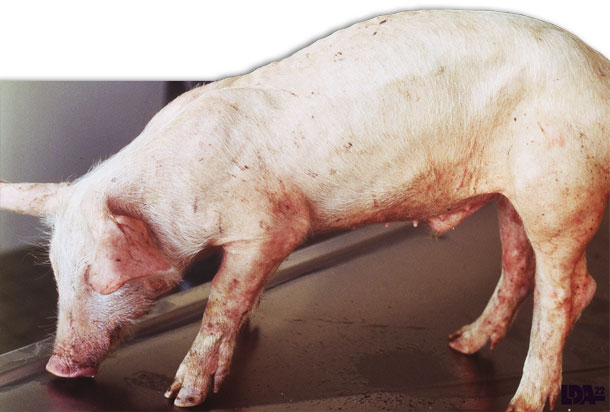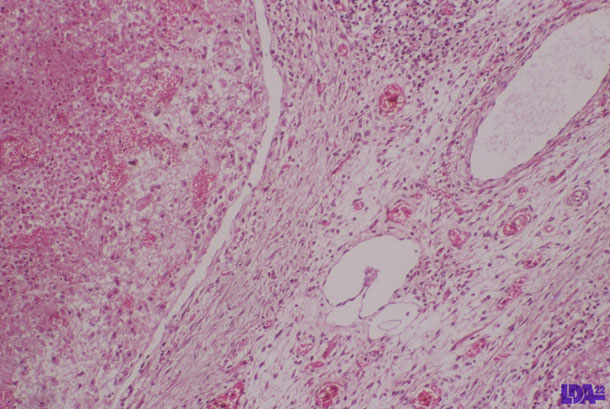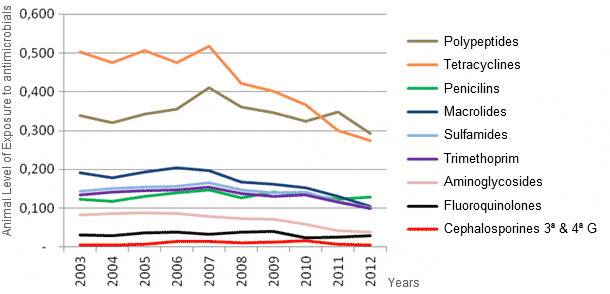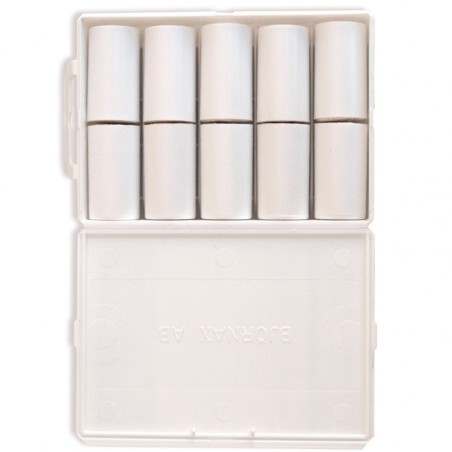In order to control antibioresistance, the use of antibiotic drugs in swine production must be more and more prudent. However, we must not forget that if they are effective to fight bacterial infections, they cannot by themselves completely cure the animals: antibiotic drugs allow stopping microbial proliferation, but final healing is achieved by immune response. Thus, any immunosuppressive agent will potentiate bacterial infections, and heavy antibiotic treatments become necessary to prevent relapses.
Pigs are susceptible to various immunosuppressive agents, amongst them PCV2 is what shows a most pronounced immunosuppressive effect, even if reversible, acting on both humoral and cellular immunity. It induces functional failure of alveolar macrophages, transient decline of phagocytes, dendritic cells, T lymphocytes -especially CD4 cells and B cells- and thymus, accompanied by a pronounced lymphopenia. It may also interfere maturation of B lymphocytes and antibody response. It can impede the expression capacity of several cytokines, thus allowing the infection by secondary pathogens, as well virus as bacteria. The functional failure of alveolar macrophages induces a persistent decline in their microbicidal capacity, explaining the potentialisation of respiratory infections and, obviously, an increased need for antibiotic treatments (Abelardo Silva et al, 2012).


Photo 1. PMWS on piglet. Dr Morvan, LDA22
Furthermore, the virus actively multiplies in the intestinal mucosa, inducing an alteration of its structure, with a necrotic and granulomatous enteritis, often confused with ileitis caused by Lawsonia intracellularis and even with chronic form of swine dysentery (Zlotowski et al 2010). Once more, antiinfectious drugs are needed. Long and unncessary antibiotic treatments are applied when PCV2 infection is not controlled.

Photo 2. Lymph node necrosis on PCV2 infected piglet. Dr Morvan, LDA22
The history of PMWS (Post Weaning Multisystemic Wasting Disease, due to PCV2) is quite explicit in this respect. When the disease first appeared, in 1997 in France –first country affected in Europe–, antibiotic consumptions globally jumped in all areas of production. They were progressively reduced when vaccines began to be used. In France, vaccination began on a small scale in 2004, thanks to a provisional license issued by the French Agency for Animal Health and Food Safety (AFSSA) for an inactivated PCV2 vaccine intended for the vaccination of sows and gilts. From 2007, when other vaccines got official market authorization for sow or piglets, vaccination was widely used in France and the reduction of the use of antibiotics became obvious. This reduction is clear for all antibiotic families, but penicillins, fluoroquinolones and cephalosporins. For these 3 families the consumption remains stable, and for the two last families, is low (figure 1).

Figure 1. Evolution of pig antibiotics consumption between 2003 and 2012 in France (ANSES 2014)
Precise data have been collected all over the world. In Asia, a Korean observation was performed in a farrow to finish unit of 200 sows. The cost of antibiotic medication was divided by 2 after vaccination (Chae et al 2013). In Canada, in a high-level sow herd, free of PRRS and Mycoplasma hyopneumoniae, achieving almost 28 pigs weaned per sow per year, PCV2 vaccination has allowed to still improve technico-economical results and to reduce antibiotic consumption by more than 50% (Glass 2010).
European data are also numerous. In UK, a 4 000 places finishing herd affected with complex respiratory problems involving PRRS, Enzootic Pneumonia, PCVD, Actinobacillus pleuropneumoniae and other secondary bacterial infections started sow vaccination in 2007 and piglets from vaccinated sows reached the unit in July. In December, the cost of treatments was divided by 10 (table I, Waddilove 2008).
Table I. Medication cost per pig in a 4000 place unit before and after PCV2 vaccination (UK £ per pig) (Waddilove, 2008).
| Quarter ended | Dec 2006 | March 2007 | June 2007 | September 2007 | December 2007 |
| Feed medication | 0.255 | 0.282 | 0.295 | 0.004 | 0 |
| Total costs | 0.325 | 0.360 | 0.330 | 0.082 | 0.027 |
In Denmark, in 3 farrow-to-finish units of respectively 110, 120 and 360 sows, vaccination reduced very significantly antibiotic consumption in the post-weaning and mainly the fattening period, in spite of a high prevalence of digestive troubles due to a coinfection Escherichia coli - Lawsonia intracellularis (table II, Ovesen et Kunstmann 2008). A Dutch study highlights a reduction of 49% (Van Dommelen et Wertenbroek 2011), while, in France, health expenses per sow fall from 182 to 147 Euros (Delisle 2009).
Table II. Comparison between Average Daily Dose before and after PCV2 vaccination
in 3 Danish farms (Ovesen et Kunstmann, 2008).
| Herd 1 | Before vaccination | After vaccination |
| Weaners | 34.9 | 16.1** |
| Finishers | 4.04 | 0.37** |
| Herd 2 | Before vaccination | After vaccination |
| Weaners | 0.58 | 16.3**a |
| Finishers | 0.61 | 0.04 |
| Herd 3 | Before vaccination | After vaccination |
| Weaners | 11.1 | 10.2 |
| Finishers | 1.65 | 0.4 |
a Treatments due to E. coli and Lawsonia diarrhoea. ** p < 0.01
Thus, vaccination against PCV2 is valuable means of controlling digestive and respiratory ifections, of reducing mortality, improving growth rate, while reducing the use of antiinfectious drugs. Immunity must be maintained in suckling piglets, thanks to colostrum. After weaning, active immunization of piglets is essential to extend protection until the end of the fattening period. Growth is improved and more regular. This better homogeneity prevent mixing animal of different batches and different ages. This practice cannot be avoid when health is poor, but often needs antiinfectious treatments, due to the different microbial loads of the newly grouped piglets. The benefit on antibiotic use is particularly clear when herds are multicontaminated by pathogenic virus and bacteria, allowing also to maintain animal welfare and operational productivity, but a good immunity against PCV2 is effective also in high health status herds.







